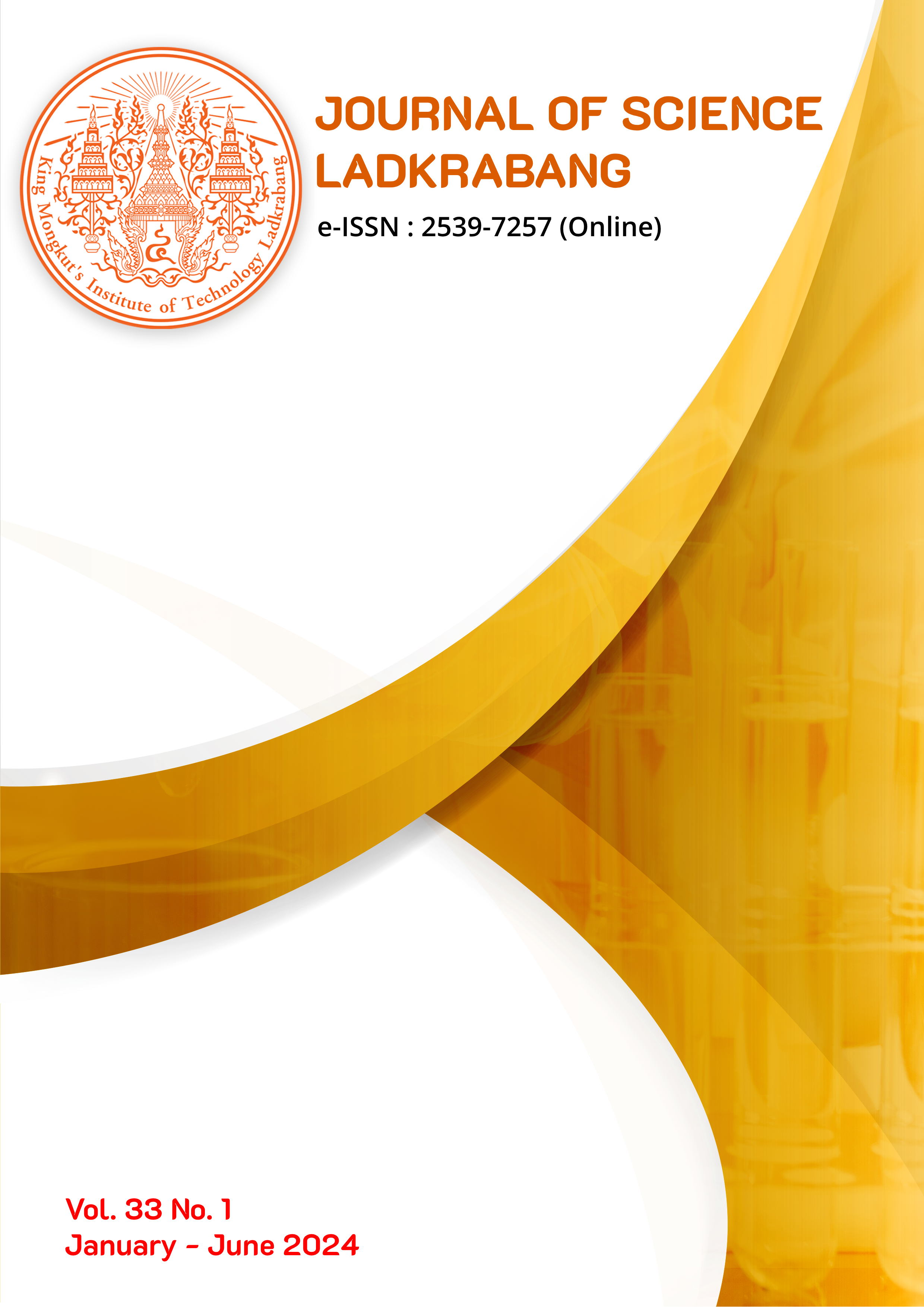Study of the 5th Wave of COVID-19 Outbreak in Thailand Using Mathematical Model
Main Article Content
Abstract
Covid-19 is a contagious disease that is transmitted from person to person through small droplets released when coughing or sneezing. Currently, Thailand is experiencing an outbreak of the Omicron variant of the Covid-19 virus in its fifth wave, with a high number of infected individuals compared to previous waves. Therefore, we are interested to study the spread of the disease and the effectiveness of the three-dose vaccination using Mathematical model. To analyze the spread and study the impact of vaccination, we developed a mathematical model consisting of eight population groups: Susceptible population (S), Vaccinated population at risk (Sv), Infected population with mild symptoms (I), Hospitalized population with severe symptoms (H1), ICU-admitted population in critical condition (C), Hospitalized population recovering from ICU treatment (H2), Recovered population (R), Death population (D). In our investigation of COVID-19 spread and the effectiveness of vaccination, we determined crucial epidemiological factors, including the endemic equilibrium and the basic reproduction number (R0). We then conduct mathematical and numerical analysis of the model. Our findings indicate that the endemic equilibrium is stable whenever R0>1 and unstable when R0<1. Additionally, we performed sensitivity analyses on the model, examining the impact of the basic reproduction number. Notably, parameters τi,mi, and γ demonstrated significant influence on the infection rate (basic reproduction number), while parameters β,η, and sv^i primarily influenced the magnitude of the infected population during an epidemic. Moreover, the first and second vaccine doses have similar effect in controlling the spread of COVID-19, while the complete three-dose vaccination demonstrated superior effectiveness in mitigating transmission compared to vaccination with only one or two doses.
Article Details

This work is licensed under a Creative Commons Attribution-NonCommercial-NoDerivatives 4.0 International License.
References
Huang, C. et al. 2020. Clinical features of patients infected with 2019 novel coronavirus in Wuhan, China. The Lancet, 395(10223), 497-506, https://doi.org/10.1016/S0140-6736(20)30183-5.
Worid Health Organization. 2021. Listings of WHO’s response to COVID-19. Available at: https://www.who.int/news/item/29-06-2020-covidtimeline. Retrieved 16 May 2023.
BARRETO, C. and MEJIA, M. 2021. Peru’s intensive care units at capacity as virus cases surge. Available at: https://apnews.com/article/lima-coronavirus-pandemic-peru-847fb33c1f5c49ca70b66227f0435e2e. Retrieved 16 May 2023.
National Statistical Office. 2021. Demography Population and Housing. Available at: http://statbbi.nso.go.th/staticreport/page/sector/th/01.aspx. Retrieved 19 May 2023.
Department of Disease Control. 2022. DDC COVID-19 Interactive Dashboard. Available at: https://ddc.moph.go.th/covid19-dashboard/?dashboard=main. Retrieved 12 May 2023.
Rajatanavin, N., Tuangratananon, T., Suphanchaimat, R. and Tangcharoensathien, V. 2021. Responding to the COVID-19 second wave in Thailand by diversifying and adapting lessons from the first wave. BMJ global health, 6(7), https://doi.org/10.1136/bmjgh-2021-006178.
World Health Organization Country Office for Thailand. 2022. COVID-19 Situation in Thailand. Available at: https://t.ly/bm8Ac. Retrieved 17 May 2023.
Keeling, M.J., and Rohani, P. 2008. Modeling Infectious Diseases in Humans and Animals, Princeton University Press, https://doi.org/10.2307/j.ctvcm4gk0.
Chen, Z. et al. 2022. SEIR model with unreported infected population and dynamic parameters for the spread of COVID-19. Mathematics and computers in simulation, 198, 31-46, https://doi.org/10.1016/j.matcom.2022.02.025.
Teklu, S. W. 2022. Mathematical analysis of the transmission dynamics of COVID-19 infection in the presence of intervention strategies. Journal of Biological Dynamics, 16(1), 640-664, https://doi.org/10.1080/17513758.2022.2111469.
Ayoola, T. A., Kolawole, M. K. and Popoola, A. O. 2022. Mathematical model of COVID-19 transmission dynamics with double dose vaccination. Tanzania Journal of Science, 48(2), 499-512, https://doi.org/10.4314/tjs.v48i2.23.
Marinov, T. T. and Marinova, R. S. 2022. Inverse problem for adaptive SIR model: Application to COVID-19 in Latin America. Infectious Disease Modelling, 7(1), 134-148, https://doi.org/10.1016/j.idm.2021.12.001.
Youssef, H., Alghamdi, N., Ezzat, M. A., El-Bary, A. A. and Shawky, A. M. 2021. Study on the SEIQR model and applying the epidemiological rates of COVID-19 epidemic spread in Saudi Arabia. Infectious Disease Modelling, 6, 678-692, https://doi.org/10.1016/j.idm.2021.04.005.
Alqahtani, R. T. 2021. Mathematical model of SIR epidemic system (COVID-19) with fractional derivative: stability and numerical analysis. Advances in Difference Equations, 2021(1), 1-16, https://doi.org/10.1186/s13662-020-03192-w.
Ahmad, N. 2020. COVID-19 modeling in Saudi Arabia using the modified Susceptible-Exposed-Infectious-Recovered (SEIR) model. Cureus, 12(9), https://doi.org/10.7759/cureus.10452.
Theparod, T., Kreabkhontho, P. and Teparos, W. 2023. Booster Dose Vaccination and Dynamics of COVID-19 Pandemic in the Fifth Wave: An Efficient and Simple Mathematical Model for Disease Progression. Vaccines, 11(3), 589, https://doi.org/10.3390/vaccines11030589.
Ledford, H. 2020. COVID-19 reinfection: three questions scientists are asking. Nature, 585(7824), 168-169, https://doi.org/10.1038/d41586-020-02506-y.
The Bureau of Registration Administration. 2021. Number of births and deaths in Thailand 2021. Available at: https://t.ly/BS9lw. Retrieved 22 May 2023.
Van den Driessche, P. and Watmough, J. 2002. Reproduction numbers and sub-threshold endemic equilibria for compartmental models of disease transmission. Mathematical biosciences, 180(1-2), 29-48, https://doi.org/10.1016/S0025-5564(02)00108-6.
PHAT, B. and Ngoc, V. 2001. Introduction to mathematical control theory. Hanoi National University Publisher, Hanoi.
DeJesus, E.X. and C. Kaufman. 1987. Routh-Hurwitz criterion in the examination of eigenvalues of a system of nonlinear ordinary differential equations. Physical Review A, 35(12), 5288, https://doi.org/10.1103/PhysRevA.35.5288.
Department of Disease Control. 2021. Guidelines for people who need COVID-19 Epidemic Situation 2021 in Thailand. Available at: https://ddc.moph.go.th/vaccine-covid19/getFiles/11/1628849610213.pdf. Retrieved 19 May 2023.
Chitnis, N., Hyman, J.M., and Cushing, J.M. 2008. Determining important parameters in the spread of malaria through the sensitivity analysis of a mathematical model. Bulletin of mathematical biology, 70, 1272-1296, https://doi.org/10.1007/s11538-008-9299-0.
Coutsias, E.A., Seok, C. and Dill, K.A. 2004. Using quaternions to calculate RMSD. Journal of Computational Chemistry, 25(15), 1849-1857, https://doi.org/10.1002/jcc.20110.

